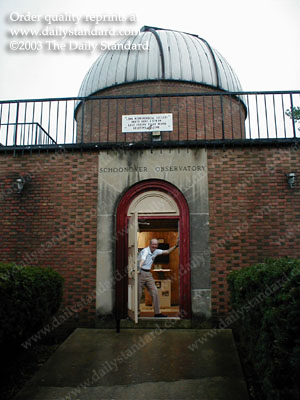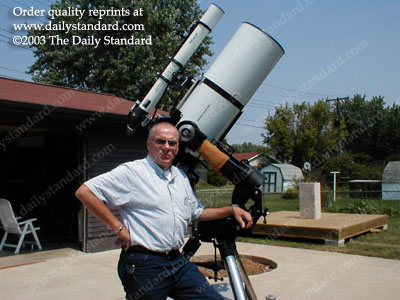By JANIE SOUTHARD
jsouthard@dailystandard.com
If you didn’t see Mars early Wednesday morning, you missed
it at its absolute closest to Earth in 60,000 years, but all
is not lost.
The planet will be in good sight for several weeks and even
better views are coming this fall when the temperature cools.
“Wednesday morning (was) just a statistics chase —
just to say you saw it at its closest (34,646,418 miles from
Earth),” amateur astronomer and deep space photographer
Bill Grunden of St. Marys told The Daily Standard on Monday
afternoon.
Too much “junk” in the air, he claims, make the
planet fuzzy at this time of year.
“Heat and humidity distort things right now. It’s
like looking through the shimmering heat that rises off the
road in the summer,” he said.
But what’s so great about all the Mars hype is that people
are a lot more interested in space.
“Interest in Mars and astronomy in general is really cookin’
right now and that’s good,” the retired St. Marys
police officer said.
Grunden, who now owns an impressive telescope and viewing equipment,
said when he first became seriously interested in astronomy
about a decade ago he could hardly locate the moon through his
scope.
Now he’s had several space photos published and seems
eager to get everyone, especially kids, looking up.
“You can definitely see Mars now with any telescope, binoculars
or the naked eye. I’ll look too, but I’m not all
wound up about it,” he said, again underscoring the view
is going to get better later.
M.D. Wilson of the Lima Astronomical Society agreed the view
now is fuzzy.
“But Mars is a unique, tantalizing planet any time you
see it,” Wilson told The Daily Standard on Tuesday at
the Schoonover Observatory in Lima.
The orange disk, fourth planet from the sun, has a way of teasing
the viewer.
“You look and stare, look and stare through the telescope
and its always fuzzy because, of course, you’re looking
through about 50 miles of atmosphere.
“But, suddenly, for a split second, the atmosphere clears
and there it is. You see definition. It’s an unforgettable
sight,” Wilson said.
Although you won’t have to wait another 60,000 years for
a close encounter with Mars, no one living today will see it
the next time it’s really close in 2287.
So, why is it so close now?
With apologies to all mathematicians, the simple answer is crazy
orbits have linked up.
Although all planets orbit the sun at different speeds, the
orbits are not circles. They’re more oval (elliptic).
Mars’ orbit is more off center than Earth’s, which
brings them closest every 26 months.
Why 26 months?
Earth makes a complete orbit in 365.25 days. The complete Martian
orbit is 687 Earth-days, about twice as long. Thus, it takes
about two years for the two orbits to get as close as they’re
going to during that period.
Wilson said some years close means as much as 63 million miles.
So the red planet now begins its drift away. In October 2005
the closest distance will be 43 million miles; in December 2007,
it’s 55 million miles; and March 2012, it’s 63,000
miles.
By the way, Mars appears red for the same reason Georgia is
red.
“Iron-rich soil,” Grunden said.

|

